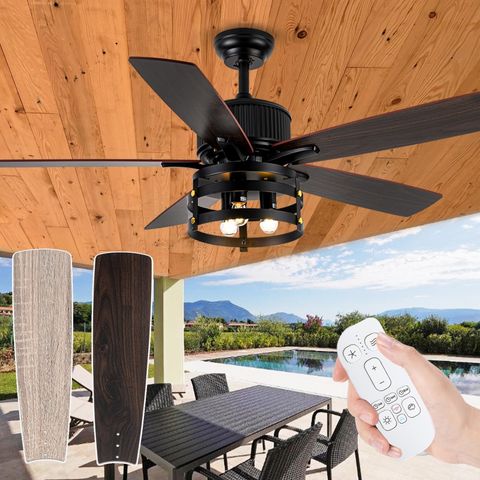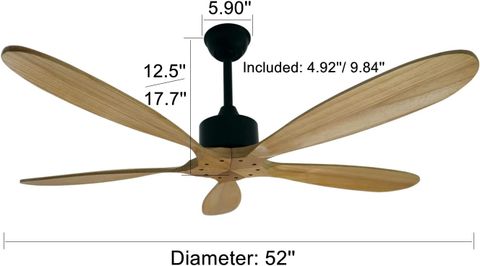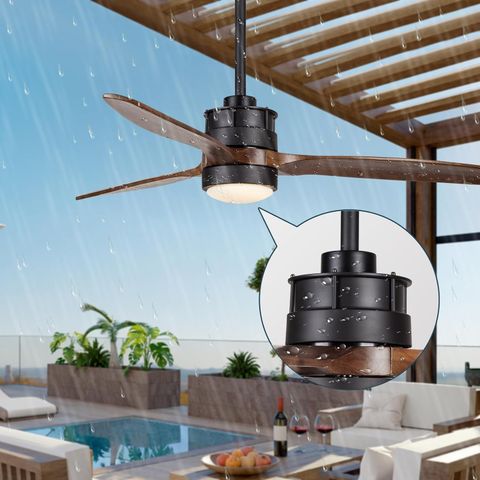When it comes to outdoor living areas, staying comfortable while being environmentally conscious is key. The right 52-inch outdoor ceiling fan can transform your patio, deck, or covered porch into a refreshing retreat. But with so many options available, how do you choose the best one that’s both energy-efficient and built to last? Let’s dive into what makes a great outdoor fan and how to pick the perfect one for your space.
Outdoor living has become a way of life for many people. Whether it’s a cozy backyard, a spacious deck, or a covered patio, we spend more time outside than ever before. But hot weather can quickly turn those pleasant evenings into uncomfortable experiences. That’s where outdoor ceiling fans come in. These powerful devices can provide relief from the heat while adding style to your outdoor area. A 52-inch fan specifically offers the right balance of airflow and coverage for most outdoor spaces. However, not all outdoor fans are created equal. Some are energy hogs, while others are designed with efficiency in mind. Choosing the right model can make all the difference between a relaxing evening and a sweltering one.
Why Choose Energy Efficient Outdoor Fans?
Energy efficiency isn’t just good for the environment—it’s good for your wallet too. When you invest in an energy-efficient outdoor ceiling fan, you’re making a smart choice that pays off over time. These fans typically use less electricity to operate, which means lower monthly bills. They’re also built to handle the elements better, so they last longer. Think about it: a fan that uses half the power of a standard model could save you hundreds of dollars over its lifetime. Plus, many of these fans come with smart features like timers and remote controls that let you customize your experience. The initial cost might be higher, but the long-term benefits make it worth every penny. It’s like having a personal air conditioning system that doesn’t break the bank.
Key Features to Look For in 52-Inch Outdoor Fans
Not all outdoor fans are the same, and there are several important features you should consider when shopping. First, look for fans with waterproof ratings. This ensures they can handle rain, humidity, and other outdoor conditions without damage. Second, check the motor quality. A good motor will run smoothly and quietly, even in high winds. Third, consider the blade design. Some blades are specifically engineered to move more air with less energy. Fourth, look for fans with energy-saving LED lights if you want to add some ambiance to your outdoor space. Finally, think about the mounting hardware and installation requirements. You want something that fits your space perfectly and won’t require expensive modifications. These features work together to create a fan that’s both functional and long-lasting.
Material and Construction Quality Matters
The materials used in building an outdoor fan play a huge role in its performance and durability. Aluminum is a popular choice because it’s lightweight yet strong, and it won’t rust like steel might. Stainless steel components offer extra protection against corrosion, especially in coastal areas. Some fans feature powder-coated finishes that resist fading from UV rays and weather exposure. The blades themselves are critical—they need to be thick enough to generate good airflow but thin enough to reduce wind resistance. Pay attention to how well the fan is assembled and whether it meets industry standards for outdoor use. A well-built fan will handle everything from summer heat to winter storms, while a poorly constructed one might fail after just a few seasons. Quality materials and construction mean fewer repairs and replacements down the road.
Power Consumption and Efficiency Ratings Explained
Understanding power consumption can help you choose the most economical option for your needs. Most outdoor fans range from 50 to 150 watts, depending on their size and features. Look for fans with ENERGY STAR certification, which indicates they meet strict energy efficiency guidelines set by the government. These fans use significantly less electricity than standard models while providing the same level of comfort. The airflow rating, measured in cubic feet per minute (CFM), tells you how much air the fan moves. Higher CFM numbers usually mean better cooling performance, but they also often require more power. Consider the size of your space when evaluating these ratings. A large 52-inch fan in a big deck area will need more power than a smaller fan in a compact patio. Some fans even have variable speed settings that let you adjust airflow based on conditions.
Popular Brands and Their Strengths
Several brands have established themselves as leaders in outdoor fan technology. Some focus on traditional designs with proven reliability, while others push the boundaries with innovative features. Brands like Hunter, Hampton Bay, and Commercial Electric offer solid options that combine good performance with reasonable prices. These companies often have extensive dealer networks and good customer service support. Newer brands might offer cutting-edge features like smart home integration or solar power options. When comparing brands, consider factors like warranty coverage, customer reviews, and availability of replacement parts. A brand with a good reputation for customer support can save you headaches later if something goes wrong. Research what other homeowners in your area have experienced with different brands to get a sense of real-world performance. Word-of-mouth recommendations often reveal the true quality of a product.
Installation Tips and Common Mistakes to Avoid
Proper installation is crucial for getting the most out of your outdoor fan. Many people try to install them themselves, which can work if you have experience with electrical work. However, outdoor installations often require special considerations. Make sure your electrical box can handle the fan’s weight and power requirements. Check that your ceiling can support the load, especially if you’re installing in a covered area. One common mistake is choosing a fan that’s too small for the space—this leads to inadequate airflow and poor performance. Another frequent error is improper blade height, which can cause safety issues or reduce effectiveness. Always follow manufacturer instructions carefully and consider hiring a professional if you’re unsure about any aspect of the installation. Proper installation ensures maximum efficiency and safety, and it helps prevent costly repairs later on. Don’t skimp on this step—your investment deserves proper setup.
Choosing the right 52-inch outdoor ceiling fan is about balancing performance, efficiency, and value. You want something that keeps you cool during hot summer months while being built to withstand the elements year-round. By focusing on energy efficiency, quality materials, and proper installation, you can find a fan that enhances your outdoor living experience. Remember that the best fan for you depends on your specific space, budget, and preferences. Take time to research different options and consider what matters most to you. Whether you prioritize quiet operation, smart features, or simple reliability, there’s a fan out there that’s perfect for your outdoor sanctuary. The investment you make today will pay dividends in comfort and savings for many seasons to come. Your outdoor space deserves nothing less than the best.














